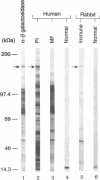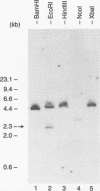Abstract
While there is no direct evidence demonstrating the existence of protective immunity to Wuchereria bancrofti infection in humans, the presence of individuals, in populations in areas where infection is endemic, with no clinical evidence of past or current infection despite appreciable exposure to the infective larvae, suggests that protective immunity to filarial parasites may occur naturally. Earlier work indicated that such putatively immune individuals generated antibodies to a 43-kDa antigen from larval extracts of the related filarial parasite Brugia malayi that was recognized by only 8% of the infected population. With rabbit antiserum raised against this 43-kDa antigen, this current study identified a recombinant clone, WbN43, with an insert size of 2.3 kb, from a W. bancrofti genomic expression library. The recombinant fusion protein was differentially recognized by the putatively immune individuals but not by the infected patients. The coding sequence (684 bp) from the 5' end had significant sequence similarity to chitinases from Serratia marcescens, Bacillus circulans, Streptomyces plicatus, and B. malayi. Peptide sequencing of the expressed product also defined a chitinase-like sequence. Molecular characterization indicated WbN43 to be a low-copy-number gene, with expression predominantly in infective larvae and microfilariae but not in adult parasites.
Full text
PDF







Images in this article
Selected References
These references are in PubMed. This may not be the complete list of references from this article.
- Beall J. A., Mitchell G. F. Identification of a particular antigen from a parasite cDNA library using antibodies affinity purified from selected portions of Western blots. J Immunol Methods. 1986 Feb 12;86(2):217–223. doi: 10.1016/0022-1759(86)90456-4. [DOI] [PubMed] [Google Scholar]
- Blair L. S., Campbell W. C. Immunization of ferrets against Dirofilaria immitis by means of chemically abbreviated infections. Parasite Immunol. 1981 Summer;3(2):143–147. doi: 10.1111/j.1365-3024.1981.tb00392.x. [DOI] [PubMed] [Google Scholar]
- Bradshaw H. D., Jr Killer toxins. Nature. 1990 May 24;345(6273):299–299. doi: 10.1038/345299b0. [DOI] [PubMed] [Google Scholar]
- Chan S. H., Dissanayake S., Mak J. W., Ismail M. M., Wee G. B., Srinivasan N., Soo B. H., Zaman V. HLA and filariasis in Sri Lankans and Indians. Southeast Asian J Trop Med Public Health. 1984 Sep;15(3):281–286. [PubMed] [Google Scholar]
- Day K. P., Gregory W. F., Maizels R. M. Age-specific acquisition of immunity to infective larvae in a bancroftian filariasis endemic area of Papua New Guinea. Parasite Immunol. 1991 May;13(3):277–290. doi: 10.1111/j.1365-3024.1991.tb00282.x. [DOI] [PubMed] [Google Scholar]
- Day K. P., Grenfell B., Spark R., Kazura J. W., Alpers M. P. Age specific patterns of change in the dynamics of Wuchereria bancrofti infection in Papua New Guinea. Am J Trop Med Hyg. 1991 May;44(5):518–527. doi: 10.4269/ajtmh.1991.44.518. [DOI] [PubMed] [Google Scholar]
- Denham D. A., McGreevy P. B., Suswillo R. R., Rogers R. The resistance to re-infection of cats repeatedly inoculated with infective larvae of Brugia pahangi. Parasitology. 1983 Feb;86(Pt 1):11–18. doi: 10.1017/s0031182000057127. [DOI] [PubMed] [Google Scholar]
- Denham D. A., Medeiros F., Baldwin C., Kumar H., Midwinter I. C., Birch D. W., Smail A. Repeated infection of cats with Brugia pahangi: parasitological observations. Parasitology. 1992 Jun;104(Pt 3):415–420. doi: 10.1017/s0031182000063666. [DOI] [PubMed] [Google Scholar]
- Devereux J., Haeberli P., Smithies O. A comprehensive set of sequence analysis programs for the VAX. Nucleic Acids Res. 1984 Jan 11;12(1 Pt 1):387–395. doi: 10.1093/nar/12.1part1.387. [DOI] [PMC free article] [PubMed] [Google Scholar]
- Flach J., Pilet P. E., Jollès P. What's new in chitinase research? Experientia. 1992 Aug 15;48(8):701–716. doi: 10.1007/BF02124285. [DOI] [PubMed] [Google Scholar]
- Freedman D. O., Nutman T. B., Ottesen E. A. Enhanced solubilization of immunoreactive proteins from Brugia malayi adult parasites using cetyltrimethylammonium bromide. Exp Parasitol. 1988 Apr;65(2):244–250. doi: 10.1016/0014-4894(88)90128-2. [DOI] [PubMed] [Google Scholar]
- Freedman D. O., Nutman T. B., Ottesen E. A. Protective immunity in bancroftian filariasis. Selective recognition of a 43-kD larval stage antigen by infection-free individuals in an endemic area. J Clin Invest. 1989 Jan;83(1):14–22. doi: 10.1172/JCI113850. [DOI] [PMC free article] [PubMed] [Google Scholar]
- Fuhrman J. A., Lane W. S., Smith R. F., Piessens W. F., Perler F. B. Transmission-blocking antibodies recognize microfilarial chitinase in brugian lymphatic filariasis. Proc Natl Acad Sci U S A. 1992 Mar 1;89(5):1548–1552. doi: 10.1073/pnas.89.5.1548. [DOI] [PMC free article] [PubMed] [Google Scholar]
- Fuhrman J. A., Piessens W. F. A stage-specific calcium-binding protein from microfilariae of Brugia malayi (Filariidae). Mol Biochem Parasitol. 1989 Jul;35(3):249–257. doi: 10.1016/0166-6851(89)90211-9. [DOI] [PubMed] [Google Scholar]
- Gooday G. W., Brydon L. J., Chappell L. H. Chitinase in female Onchocerca gibsoni and its inhibition by allosamidin. Mol Biochem Parasitol. 1988 Jun;29(2-3):223–225. doi: 10.1016/0166-6851(88)90077-1. [DOI] [PubMed] [Google Scholar]
- Grieve R. B., Abraham D., Mika-Grieve M., Seibert B. P. Induction of protective immunity in dogs to infection with Dirofilaria immitis using chemically-abbreviated infections. Am J Trop Med Hyg. 1988 Oct;39(4):373–379. doi: 10.4269/ajtmh.1988.39.373. [DOI] [PubMed] [Google Scholar]
- Harpster M. H., Dunsmuir P. Nucleotide sequence of the chitinase B gene of Serratia marcescens QMB1466. Nucleic Acids Res. 1989 Jul 11;17(13):5395–5395. doi: 10.1093/nar/17.13.5395. [DOI] [PMC free article] [PubMed] [Google Scholar]
- Hayashi Y., Noda K., Shirasaka A., Nogami S., Nakamura M. Vaccination of BALB/c mice against Brugia malayi and B. pahangi with larvae attenuated by gamma irradiation. Jpn J Exp Med. 1984 Aug;54(4):177–181. [PubMed] [Google Scholar]
- Higashi G. I., Chowdhury A. B. In vitro adhesion of eosinophils to infective larvae of Wuchereria bancrofti. Immunology. 1970 Jul;19(1):65–83. [PMC free article] [PubMed] [Google Scholar]
- Huber M., Cabib E., Miller L. H. Malaria parasite chitinase and penetration of the mosquito peritrophic membrane. Proc Natl Acad Sci U S A. 1991 Apr 1;88(7):2807–2810. doi: 10.1073/pnas.88.7.2807. [DOI] [PMC free article] [PubMed] [Google Scholar]
- Jones J. D., Grady K. L., Suslow T. V., Bedbrook J. R. Isolation and characterization of genes encoding two chitinase enzymes from Serratia marcescens. EMBO J. 1986 Mar;5(3):467–473. doi: 10.1002/j.1460-2075.1986.tb04235.x. [DOI] [PMC free article] [PubMed] [Google Scholar]
- Kafatos F. C., Jones C. W., Efstratiadis A. Determination of nucleic acid sequence homologies and relative concentrations by a dot hybridization procedure. Nucleic Acids Res. 1979 Nov 24;7(6):1541–1552. doi: 10.1093/nar/7.6.1541. [DOI] [PMC free article] [PubMed] [Google Scholar]
- Laemmli U. K. Cleavage of structural proteins during the assembly of the head of bacteriophage T4. Nature. 1970 Aug 15;227(5259):680–685. doi: 10.1038/227680a0. [DOI] [PubMed] [Google Scholar]
- O'Farrell P. H. High resolution two-dimensional electrophoresis of proteins. J Biol Chem. 1975 May 25;250(10):4007–4021. [PMC free article] [PubMed] [Google Scholar]
- Ottesen E. A. Immunological aspects of lymphatic filariasis and onchocerciasis in man. Trans R Soc Trop Med Hyg. 1984;78 (Suppl):9–18. doi: 10.1016/0035-9203(84)90309-2. [DOI] [PubMed] [Google Scholar]
- Ottesen E. A., Mendell N. R., MacQueen J. M., Weller P. F., Amos D. B., Ward F. E. Familial predisposition to filarial infection--not linked to HLA-A or-B locus specificities. Acta Trop. 1981 Sep;38(3):205–216. [PubMed] [Google Scholar]
- Ottesen E. A., Weller P. F., Heck L. Specific cellular immune unresponsiveness in human filariasis. Immunology. 1977 Sep;33(3):413–421. [PMC free article] [PubMed] [Google Scholar]
- Ottesen E. A., Weller P. F., Lunde M. N., Hussain R. Endemic filariasis on a Pacific Island. II. Immunologic aspects: immunoglobulin, complement, and specific antifilarial IgG, IgM, and IgE antibodies. Am J Trop Med Hyg. 1982 Sep;31(5):953–961. [PubMed] [Google Scholar]
- Partono F. Elephantiasis and its relation to filarial immunity. Southeast Asian J Trop Med Public Health. 1982 Jun;13(2):275–279. [PubMed] [Google Scholar]
- Piessens W. F., McGreevy P. B., Piessens P. W., McGreevy M., Koiman I., Saroso J. S., Dennis D. T. Immune responses in human infections with Brugia malayi: specific cellular unresponsiveness to filarial antigens. J Clin Invest. 1980 Jan;65(1):172–179. doi: 10.1172/JCI109648. [DOI] [PMC free article] [PubMed] [Google Scholar]
- Raghavan N., Maina C. V., Fitzgerald P. C., Tuan R. S., Slatko B. E., Ottesen E. A., Nutman T. B. Characterization of a muscle-associated antigen from Wuchereria bancrofti. Exp Parasitol. 1992 Dec;75(4):379–389. doi: 10.1016/0014-4894(92)90251-5. [DOI] [PubMed] [Google Scholar]
- Raghavan N., McReynolds L. A., Maina C. V., Feinstone S. M., Jayaraman K., Ottesen E. A., Nutman T. B. A recombinant clone of Wuchereria bancrofti with DNA specificity for human lymphatic filarial parasites. Mol Biochem Parasitol. 1991 Jul;47(1):63–71. doi: 10.1016/0166-6851(91)90148-y. [DOI] [PubMed] [Google Scholar]
- Rajasekariah G. R., Puri P. M., Chandrashekar R., Subrahmanyam D. Clearance of Brugia pahangi microfilariae in immunized mice. Immunol Cell Biol. 1988 Oct-Dec;66(Pt 5-6):331–336. doi: 10.1038/icb.1988.43. [DOI] [PubMed] [Google Scholar]
- Robbins P. W., Overbye K., Albright C., Benfield B., Pero J. Cloning and high-level expression of chitinase-encoding gene of Streptomyces plicatus. Gene. 1992 Feb 1;111(1):69–76. doi: 10.1016/0378-1119(92)90604-n. [DOI] [PubMed] [Google Scholar]
- Sanger F., Nicklen S., Coulson A. R. DNA sequencing with chain-terminating inhibitors. Proc Natl Acad Sci U S A. 1977 Dec;74(12):5463–5467. doi: 10.1073/pnas.74.12.5463. [DOI] [PMC free article] [PubMed] [Google Scholar]
- Schlein Y., Jacobson R. L., Shlomai J. Chitinase secreted by Leishmania functions in the sandfly vector. Proc Biol Sci. 1991 Aug 22;245(1313):121–126. doi: 10.1098/rspb.1991.0097. [DOI] [PubMed] [Google Scholar]
- Sim B. K., Kwa B. H., Mak J. W. Immune responses in human Brugia malayi infections: serum dependent cell-mediated destruction of infective larvae in vitro. Trans R Soc Trop Med Hyg. 1982;76(3):362–370. doi: 10.1016/0035-9203(82)90191-2. [DOI] [PubMed] [Google Scholar]
- Storey D. M., Al-Mukhtar A. S. Vaccination of Jirds, Meriones unguiculatus, against Litomosoides carinii and Brugia pahangi using irradiate larvae of L. carinii. Tropenmed Parasitol. 1982 Mar;33(1):23–24. [PubMed] [Google Scholar]
- Subrahmanyam D., Mehta K., Nelson D. S., Rao Y. V., Rao C. K. Immune reactions in human filariasis. J Clin Microbiol. 1978 Aug;8(2):228–232. doi: 10.1128/jcm.8.2.228-232.1978. [DOI] [PMC free article] [PubMed] [Google Scholar]
- Towbin H., Staehelin T., Gordon J. Electrophoretic transfer of proteins from polyacrylamide gels to nitrocellulose sheets: procedure and some applications. Proc Natl Acad Sci U S A. 1979 Sep;76(9):4350–4354. doi: 10.1073/pnas.76.9.4350. [DOI] [PMC free article] [PubMed] [Google Scholar]
- Vanamail P., Subramanian S., Das P. K., Pani S. P., Rajagopalan P. K., Bundy D. A., Grenfell B. T. Estimation of age-specific rates of acquisition and loss of Wuchereria bancrofti infection. Trans R Soc Trop Med Hyg. 1989 Sep-Oct;83(5):689–693. doi: 10.1016/0035-9203(89)90399-4. [DOI] [PubMed] [Google Scholar]
- Watanabe T., Suzuki K., Oyanagi W., Ohnishi K., Tanaka H. Gene cloning of chitinase A1 from Bacillus circulans WL-12 revealed its evolutionary relationship to Serratia chitinase and to the type III homology units of fibronectin. J Biol Chem. 1990 Sep 15;265(26):15659–15665. [PubMed] [Google Scholar]
- Weller P. F., Ottesen E. A., Heck L., Tere T., Neva F. A. Endemic filariasis on a Pacific island. I. Clinical, epidemiologic, and parasitologic aspects. Am J Trop Med Hyg. 1982 Sep;31(5):942–952. doi: 10.4269/ajtmh.1982.31.942. [DOI] [PubMed] [Google Scholar]
- Wong M. M., Fredericks H. J., Ramachandran C. P. Studies on immunization against Brugia malayi infection in the rhesus monkey. Bull World Health Organ. 1969 Apr;40(4):493–501. [PMC free article] [PubMed] [Google Scholar]
- Yanisch-Perron C., Vieira J., Messing J. Improved M13 phage cloning vectors and host strains: nucleotide sequences of the M13mp18 and pUC19 vectors. Gene. 1985;33(1):103–119. doi: 10.1016/0378-1119(85)90120-9. [DOI] [PubMed] [Google Scholar]
- Yates J. A., Higashi G. I. Brugia malayi: vaccination of jirds with 60cobalt-attenuated infective stage larvae protects against homologous challenge. Am J Trop Med Hyg. 1985 Nov;34(6):1132–1137. doi: 10.4269/ajtmh.1985.34.1132. [DOI] [PubMed] [Google Scholar]







